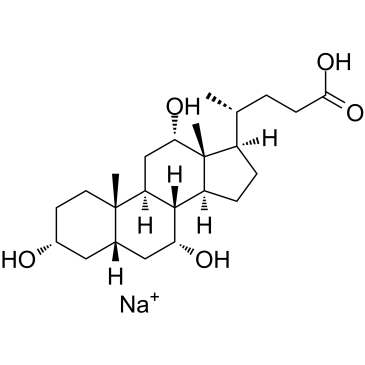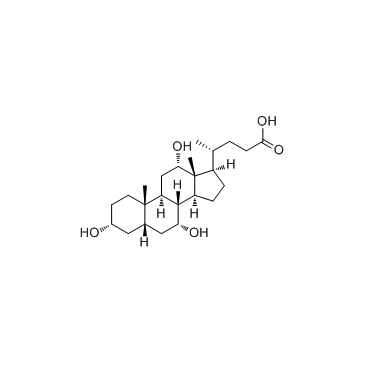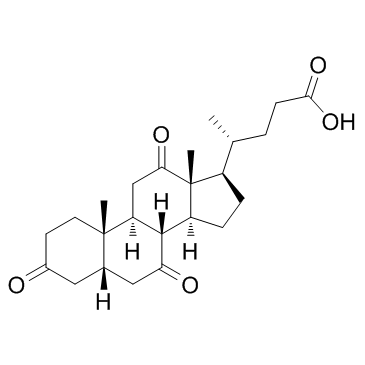sodium cholate
Modify Date: 2025-08-20 20:20:03

sodium cholate structure
|
Common Name | sodium cholate | ||
|---|---|---|---|---|
| CAS Number | 361-09-1 | Molecular Weight | 430.553 | |
| Density | N/A | Boiling Point | 583.9ºC at 760 mmHg | |
| Molecular Formula | C24H40NaO5 | Melting Point | 198ºC | |
| MSDS | Chinese USA | Flash Point | 321ºC | |
Use of sodium cholateCholic acid sodium is a major primary bile acid produced in the liver and usually conjugated with glycine or taurine. It facilitates fat absorption and cholesterol excretion. |
| Name | sodium cholate |
|---|---|
| Synonym | More Synonyms |
| Description | Cholic acid sodium is a major primary bile acid produced in the liver and usually conjugated with glycine or taurine. It facilitates fat absorption and cholesterol excretion. |
|---|---|
| Related Catalog | |
| In Vitro | Cholic acid competitively binds Na+/taurocholate cotransporting polypeptide (NTCP) on HepG2 cells and significantly inhibits the uptake of Cholic acid (CA)-nanoliposomes (LPs)-Doxorubicin (DOX)-HCl, which indicates that CA-LPs-DOX-HCl are also uptaken via NTCP-mediated endocytosis pathway[1]. |
| Cell Assay | HepG2 cells are pretreated with the inhibitors NaN3 (1 mg/mL), Genistein (50 μg/mL), MβCD (10 mM), Nystatin (50 μg/mL), Chlorpromazine (10 μg/mL), and Cholic acid (1 mg/mL) for 30 min. After removing the inhibitors, the cells are incubated with CA-LPs for 2 h, and the cellular uptake of LPs is determined in the "In vitro cellular uptake assays" section[1]. |
| References |
| Boiling Point | 583.9ºC at 760 mmHg |
|---|---|
| Melting Point | 198ºC |
| Molecular Formula | C24H40NaO5 |
| Molecular Weight | 430.553 |
| Flash Point | 321ºC |
| Exact Mass | 430.269531 |
| PSA | 100.82000 |
| LogP | 2.11400 |
| Index of Refraction | 35 ° (C=0.6, EtOH) |
| Water Solubility | 150 g/L (20 ºC) |
Synonym:Sodium cholate; 3alpha,7alpha,12alpha-Trihydroxy-5-cholanic acid sodium salt; Cholic acid, monosodium salt, sodium cholic acid; Cholan-24-oic acid, 3,7,12-trihydroxy-, monosodium salt, (3-alpha,5-beta,7-alpha; Cholic acid, monosodium salt; D Section 2 - COMPOSITION, INFORMATION ON INGREDIENTS
Risk Phrases: None Listed. Section 3 - HAZARDS IDENTIFICATION EMERGENCY OVERVIEW
Hygroscopic (absorbs moisture from the air).The toxicological properties of this material have not been fully investigated. Potential Health Effects Eye: May cause eye irritation. Skin: May cause skin irritation. Ingestion: May cause irritation of the digestive tract. Inhalation: May cause respiratory tract irritation. May cause effects similar to those described for ingestion. Chronic: No information found. Section 4 - FIRST AID MEASURES Eyes: Immediately flush eyes with plenty of water for at least 15 minutes, occasionally lifting the upper and lower eyelids. Get medical aid immediately. Skin: Get medical aid. Get medical aid immediately. Flush skin with plenty of water for at least 15 minutes while removing contaminated clothing and shoes. Wash clothing before reuse. Ingestion: Never give anything by mouth to an unconscious person. Get medical aid immediately. Do NOT induce vomiting. If conscious and alert, rinse mouth and drink 2-4 cupfuls of milk or water. Inhalation: Get medical aid immediately. Remove from exposure and move to fresh air immediately. If not breathing, give artificial respiration. If breathing is difficult, give oxygen. Notes to Physician: Section 5 - FIRE FIGHTING MEASURES General Information: As in any fire, wear a self-contained breathing apparatus in pressure-demand, MSHA/NIOSH (approved or equivalent), and full protective gear. During a fire, irritating and highly toxic gases may be generated by thermal decomposition or combustion. Extinguishing Media: Use water spray, dry chemical, carbon dioxide, or appropriate foam. Section 6 - ACCIDENTAL RELEASE MEASURES General Information: Use proper personal protective equipment as indicated in Section 8. Spills/Leaks: Sweep up, then place into a suitable container for disposal. Avoid generating dusty conditions. Provide ventilation. Section 7 - HANDLING and STORAGE Handling: Wash thoroughly after handling. Remove contaminated clothing and wash before reuse. Use with adequate ventilation. Avoid contact with eyes, skin, and clothing. Keep container tightly closed. Avoid ingestion and inhalation. Storage: Store in a tightly closed container. Store in a cool, dry, well-ventilated area away from incompatible substances. Store protected from moisture. Section 8 - EXPOSURE CONTROLS, PERSONAL PROTECTION Engineering Controls: Facilities storing or utilizing this material should be equipped with an eyewash facility and a safety shower. Use adequate ventilation to keep airborne concentrations low. Exposure Limits CAS# 361-09-1: Personal Protective Equipment Eyes: Wear appropriate protective eyeglasses or chemical safety goggles as described by OSHA's eye and face protection regulations in 29 CFR 1910.133 or European Standard EN166. Skin: Wear appropriate protective gloves to prevent skin exposure. Clothing: Wear appropriate protective clothing to prevent skin exposure. Respirators: A respiratory protection program that meets OSHA's 29 CFR 1910.134 and ANSI Z88.2 requirements or European Standard EN 149 must be followed whenever workplace conditions warrant respirator use. Section 9 - PHYSICAL AND CHEMICAL PROPERTIES Physical State: Crystals Color: white Odor: none reported pH: Not available. Vapor Pressure: Not available. Viscosity: Not available. Boiling Point: Not available. Freezing/Melting Point: 198 deg C Autoignition Temperature: Not applicable. Flash Point: Not applicable. Explosion Limits, lower: Not available. Explosion Limits, upper: Not available. Decomposition Temperature: Not available. Solubility in water: Soluble. Specific Gravity/Density: Not available. Molecular Formula: C24H39NaO5 Molecular Weight: 430.55 Section 10 - STABILITY AND REACTIVITY Chemical Stability: Stable under normal temperatures and pressures. Conditions to Avoid: Incompatible materials, strong oxidants, exposure to moist air or water. Incompatibilities with Other Materials: Oxidizing agents, moisture. Hazardous Decomposition Products: Acrid smoke and fumes. Hazardous Polymerization: Has not been reported. Section 11 - TOXICOLOGICAL INFORMATION RTECS#: CAS# 361-09-1: FZ9600000 LD50/LC50: CAS# 361-09-1: Oral, mouse: LD50 = 2400 mg/kg. Carcinogenicity: Cholic acid sodium salt - Not listed by ACGIH, IARC, or NTP. Other: See actual entry in RTECS for complete information. Section 12 - ECOLOGICAL INFORMATION Section 13 - DISPOSAL CONSIDERATIONS Dispose of in a manner consistent with federal, state, and local regulations. Section 14 - TRANSPORT INFORMATION IATA Not regulated as a hazardous material. IMO Not regulated as a hazardous material. RID/ADR Not regulated as a hazardous material. Section 15 - REGULATORY INFORMATION European/International Regulations European Labeling in Accordance with EC Directives Hazard Symbols: Not available. Risk Phrases: Safety Phrases: S 24/25 Avoid contact with skin and eyes. S 28A After contact with skin, wash immediately with plenty of water. S 37 Wear suitable gloves. S 45 In case of accident or if you feel unwell, seek medical advice immediately (show the label where possible). WGK (Water Danger/Protection) CAS# 361-09-1: 1 Canada CAS# 361-09-1 is listed on Canada's DSL List. CAS# 361-09-1 is not listed on Canada's Ingredient Disclosure List. US FEDERAL TSCA CAS# 361-09-1 is listed on the TSCA inventory. SECTION 16 - ADDITIONAL INFORMATION N/A |
CHEMICAL IDENTIFICATION
HEALTH HAZARD DATAACUTE TOXICITY DATA
|
| Precursor 1 | |
|---|---|
| DownStream 1 | |
| colalin |
| cholic acid sodium |
| cholsaeure |
| sodium salt of cholic acid |
| Cholic acid,sodium salt |
| EINECS 206-643-5 |
| 7,12-Triol |
| Cholic acid |
| CHOLALIC ACID |
| SodiumCholate |
| CHOLIC ACID NA-SALT |
| 3α,7α,12α-Trihydroxy-5β-cholan-24-oic acid sodium salt,Cholalic acid sodium salt |
| deoxycholic acid sodium salt |
| MFCD00064138 |
| SODIUMCHOLATE,REAGENT |
| SODIUM CHOLEATE |
| Sodium cholate |
| CHOLIC ACID SODIUM SALT |
 CAS#:81-25-4
CAS#:81-25-4 CAS#:81-23-2
CAS#:81-23-2
